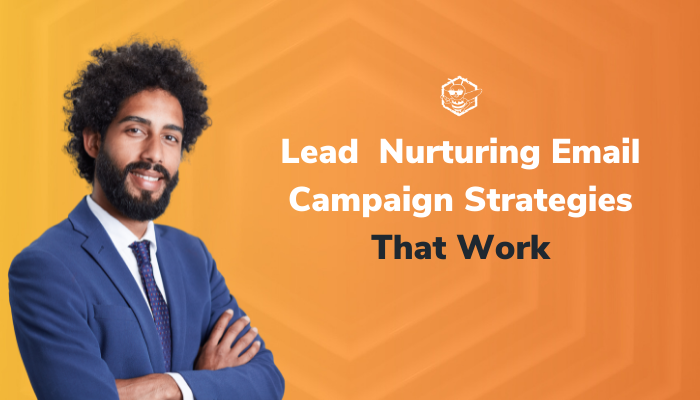Your social media manager crafts a killer post for your high-value content white paper about the benefits of your product that promises to make life easier. Analytics prove that it's working because the landing page is getting a good amount of traffic and even some downloads. You do a little internal victory dance because the time you put into bringing the white paper to life was worth it. But then, much to your dismay, crickets. Your lead fails to become a customer. Don't beat yourself up about it. The buyer's journey has just begun.
Just because they aren't ready to make a purchase right now doesn't mean they never will. Prospects need to be nurtured. According to HubSpot, it takes an average of 10 marketing touches to convert a prospect into a customer. If you haven't already, it's time to build a lead nurturing campaign.
The Value of a Lead Nurturing Email Campaign
The lead nurturing process can be an effective strategy for all stages of the sales cycle. Building trust and fostering relationships with qualified prospects is crucial to obtaining qualified leads. The goal of an effective lead nurturing campaign is to educate prospective and current customers, inform them how to advance their initiatives, engage them to begin the conversation, and ultimately convert them into a customer. Here are three basic principles we follow when creating lead nurturing email campaigns:
1. Focus on one relevant topic per email.
The last thing you want to do is overwhelm a potential customer with information about every service or product you offer. That will send them scrolling directly to the bottom of the email, searching for the unsubscribe link. You just lost a potential customer. A good rule of thumb is to consider their next logical step (remember, it's called the buyer's journey for a reason).
They are likely in the awareness stage of the buyer's journey. They've downloaded a white paper about your product because they've recognized symptoms of a problem or challenge and are trying to understand how to identify the issue — and where to begin to solve it. Providing them with a place to do additional research at their own pace will help them understand more about their problem. This is the ideal time to offer them a link to your blog. While they are gaining insight into their problem, they are also building trust in you as an industry leader.
2. Keep it short, clear, and concise.
You have less than five seconds to capture the attention of a prospect who has opened an email. The reader should be able to skim the contents to quickly determine if it holds any value for them. Take this article, for example. You saw easily skimmable section headings that clearly identified what you could expect to learn in each section.
Avoid using jargon, fluffy language, or zombie nouns (nominalization). Using these words doesn't make you appear more knowledgeable. It creates a lack of trust, causing readers to feel isolated and ultimately leads to miscommunication.
*Writing tip on zombie nouns from Helen Sword
Nominalization: "The proliferation of nominalizations in a discursive formation may be an indication of a tendency toward pomposity and abstraction."
Concise Verb: "Writers who overload their sentences with nouns derived from verbs and adjectives tend to sound pompous and abstract."
We recommend creating an outline for your email:
- Address a pain point
- Offer a solution
- Provide options for additional research
- Tell the reader what to do next
Following this outline will allow you to craft email copy that provides real value to your reader and keeps them engaged.
3. Ensure the timing and cadence of emails progress naturally.
No one likes to open their inbox to find it flooded with several sales emails on the same day from the retailer they just made a purchase from. Another sure way to lose a potential customer to the unsubscribe link. But, if you wait too long in between emails, a prospect might lose momentum or decide to look for answers elsewhere instead.
There is no magic number or equation for determining how much time should elapse between lead nurturing emails. The best way to determine what works for your audience is to evaluate your efforts by examining these key metrics consistently:
Open rate: Gauges the effectiveness of subject lines and preview text.
Clickthrough rate: Discerns what parts of an email a lead engages with and doesn't engage with, as well as if a goal is met, i.e., if a contact follows a call-to-action.
Deliverability: Examining lead engagement helps determine if you are sending to quality contacts through the number of contacts lost, emails marked as spam, hard bounces, and unsubscribes.
Click-to-conversion: Email connected to a workflow lets you see how far along in the workflow a lead travels.
Lead nurturing is an essential component of inbound marketing that can be used at any stage of the sales cycle. It allows you to generate awareness, cultivate relationships, and build credibility with current and potential customers. Providing value to your leads and customers who show an interest in your products or services motivates them to connect with you and, ideally make future purchases.
If you're ready to implement a lead nurturing email campaign into your inbound marketing strategy, you’re in luck, we're experts on the subject. The details of creating a lead nurturing campaign looks different for every business and industry. It starts with evaluating your website and content, digging into buyer personas, and determining what topics your leads are most interested in. We can help you determine what your lead nurturing process looks like, optimize your website, and level up your inbound marketing game. Talk to one of our inbound experts about your business needs today!




.png?width=100&height=100&name=Why%20Were%20Not%20a%20Marketing%20Agency%20(And%20What%20That%20Means%20for%20Your%20Growth).png)
